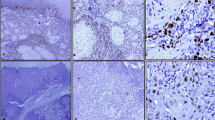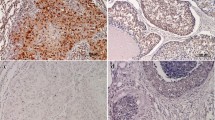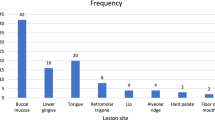Abstract
Although there are various risk factors in the literature, the established primary risk factor for oral cancer is tobacco and betal-nut chewing habits. It is believed that pathogenesis of oral cancer depends on the aetiology. To assess the histopathological grade and Ki-67 expression in tobacco (smoking/smokeless) and non-tobacco (betal nut/pan masala) habitual buccal mucosa cancer. The cross-sectional study was carried out in Regional cancer centre, Tamilnadu. Proliferative marker, Ki-67 expression was determined by immunohistochemistry using biotin-streptavidin method. The study includes 117 buccal mucosa cancer patients (61 male and 56 female). According to WHO grading system, high frequency observed with well differentiated squamous cell carcinoma 48 (41%) followed by moderate 46 (39.3%) and poorly differentiated 23 (19.7%). The cut-off value 50% was used to categorize Ki-67 expression into low and high labelling index (LI); 96 (82%) buccal mucosa cancer and 4 (3.4%) adjacent normal mucosa patients showed high Ki-67 expression. The present study showed highly significant association of histopathological tumor grade and Ki-67 expression by Chi square and paired t test p < 0.05. All the patients were grouped as tobacco 87 (74.4%) and non-tobacco habitual 30 (25.6%) in 3:1, respectively. Further, the risk habits identified with significant differences of tumor grade (p = 0.028) and Ki-67 at p < 0.05. Thus, the study revealed that the nature of cell differentiation and proliferation was strongly related to consumption of carcinogen in both tobacco and non-tobacco form. Therefore, histopathological grade and Ki-67 could be used as a reliable biomarker to understand the biological behaviour of risk habits which might helpful for further treatment therapeutics.


Similar content being viewed by others
References
Warnakulasuriya S (2009) Global epidemiology of oral and oropharyngeal cancer. Oral Oncol 45:309–316
Petersen PE (2003) Tobacco and oral health—the role of the world health organization. Oral Health Prev Dent 1:309–315
Elango JK, Sundaram KR, Gangadharan P, Subhas P, Peter S, Pulayath C et al (2009) Factors affecting oral cancer awareness in a high-risk population in India. Asian Pac J Cancer Prev 10:627–630
Subapriya R, Thangavelu A, Mathavan B, Ramachandran CR, Nagini S (2007) Assessment of risk factors for oral squamous cell cancer in Chidambaram, Soutehrn India: a case-control study. Eur J Can Prev 16(3):251–256
Scheidt JHG, Yurgel LS, Cherubini K, Figueiredo MAZ, Salum FG (2012) Characterisitcs of oral squamous cell cancer in users and non-users of tobacco and alcohol. Rev Odonto Cienc 27(1):69–73
Patil V, Baad R, Vibhute N, Belgaumi U, Kadashetti V, Bommanavar (2016) Site and habit as a determinant of grade of oral squamous cell cancer: an institution based study. Int J Oral Res 4(2):127–130
Fortin A, Wang CS, Vigneault E (2009) Influence of smoking and alcohol drinking behaviors on treatment outcomes of patients with squamous cell cancers of the head and neck. Int J Radiat Oncol Biol Phys 74:1062–1069
Scholzen T, Gerdes J (2000) The Ki-67 protein from the known and the unknown. J Cell Physiol 182:311–322
Dehimi P, Torabinia N, Torabinia A (2013) A comparative study of histopathological grade and expression of Ki-67 protein in oral squamous cell cancer in young and old patients. Dent Res J (Isfahan) 10(4):514–517
Mahima R, Pratyush S, Ankur S, Vasudeva G, Monica S (2015) Assessment of proliferative potential of tumor cells using Ki-67 expression and morphological analysis for prognostication of oral squamous cell cancers. Int J Med Res Health Sci 4(4):820–826
Pity IS, Ibrahim SN (2013) Cellular proliferation in oral mucosa atypia. Int J Sci Engi Res 4(2):1–4
Ankur B, Sonal S, Monali C (2010) Histopathological grading systems in oral squamous cell cancer: a review. J Int Oral Health 2(4):1–10
Fortin A, Couture C, Doucet R, Albert M, Allard J, Tetu B (2001) Does histopathological grade have a role in the management of head and neck cancers? J Clin Oncol 19:4107–4116
Thompson L (2006) World Health Organization classification of tumours: pathology and genetics of head and neck tumours. Ear Nose Throat J 85(2):74
Salian V, Dinakar C, Shetty P, Ajila V (2016) Etiological trends in oral squamous cell cancer: a retrospective institutional study. Cancer Transl Med 2(2):33–36
Maheshwari V, Sharma SC, Narula V, Verma S, Jain A, Alam K (2013) Prognostic and predictive impact of Ki-67 in premalignant and malignant squamous cell lesions of oral cavity. Int J Head Neck Surg 4(2):61–65
Birajdar SS, Radhika MB, Paremala K, Sudhakara M, Soumya M, Gadivan M (2014) Expression of Ki-67 in normal epithelium, leukoplakic oral epithelium and oral squamous cell cancer. J Oral Maxillofac Pathol 18(2):169–172
Miyazaki M, Ohno S, Futatsugi M, Saeki H, Ohga T, Watanabe M (2002) The relation of alcohol consumption and cigarette smoking to the multiple occurrences of esophageal dysplasia and squamous cell cancer. Surgery 131:S7–S13
Scheidt JH, Yurgel LS, Romanini J, Cherubini K, de Figueiredo MA, Salum FG (2013) Oral squamous cell cancer from users and non-users of tobacco and alcohol: clinicopathologic features and immunoreactivity of VEGF, caspase-3 and p53. App Immunohistochem Mol Morphol 21(2):148–153
Wang X, Xu J, Wang L, Liu C, Wang H (2015) The role of cigarette smoking and alcohol consumption in the differentiation of oral squamous cell cancer for the males in china. J Can Res Ther 11:141
Fang KH, Kao HK, Cheng MH, Chang YL, Tsang NM, Huang YC et al (2009) Histopathological differentiation of primary oral squamous cell cancers in an area of betel quid chewing prevalence. Otolaryngol Head Neck Surg 141(6):743–749
Acknowledgements
Our team would like to acknowledge and thank Arignar Anna Memorial Cancer Hospital and Research Centre, Kanchipuram for permitted to conduct the study.
Author information
Authors and Affiliations
Corresponding author
Ethics declarations
Conflict of interest
The authors declare that they have no conflict of interests.
Rights and permissions
About this article
Cite this article
Padma, R., Sundaresan, S., Kalaivani, A. et al. Assessment of Histopathological Grade and Ki-67 Expression in Tobacco and Non-tobacco Habitual Buccal Mucosa Cancer. Indian J Otolaryngol Head Neck Surg 71 (Suppl 1), 410–416 (2019). https://doi.org/10.1007/s12070-018-1328-1
Received:
Accepted:
Published:
Issue Date:
DOI: https://doi.org/10.1007/s12070-018-1328-1




